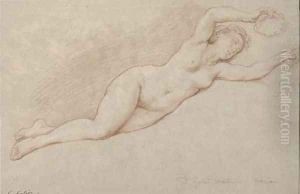Nicolas-Rene Joullain Paintings
Nicolas-René Jollain, sometimes spelled Joullain, was a French painter born on May 16, 1732, in Paris. His father, François Joullain, was an engraver and art dealer, which likely provided him with an environment conducive to nurturing his artistic talents from a young age. Little is known about Jollain’s early life, but it is presumed that he received his art education in the thriving artistic scene of Paris during the mid-18th century.
Jollain’s career is not extensively documented, but he is known to have been active during a dynamic period in French art history, which was marked by the transition from Rococo to Neoclassicism. His works encompassed various subjects including religious scenes, portraits, and genre paintings. However, unlike his contemporaries who were moving towards the Neoclassical style, Jollain’s work remained somewhat anchored to the earlier Rococo sensibility with its emphasis on ornate elegance and lighter themes.
Not much is recorded about Jollain’s patrons or the specific commissions that he may have undertaken. His presence in the Paris Salon, an official art exhibition of the Académie des Beaux-Arts in Paris, is not well documented, which suggests that he might not have been a prominent member of the artistic establishment. Despite this, he was still part of the rich tapestry of French artistic life, contributing to the cultural landscape of his time.
Jollain’s career also spans an important period in French history, including the years leading up to and including the French Revolution. How the Revolution affected his career and personal life is not well chronicled, but it undoubtedly had an impact on the art market and the type of work that was being commissioned during that tumultuous time.
Nicolas-René Jollain passed away on October 11, 1804, in Paris. Today, while he may not be as renowned as some of his peers, Jollain’s work is a part of the broader narrative of French art history. His paintings, where they survive, offer insights into the aesthetic preferences and cultural trends of his era.
